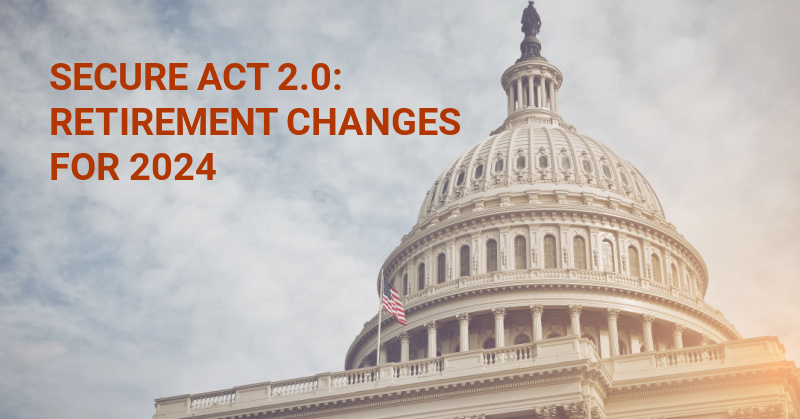When the SECURE Act 2.0 was passed in 2022 it included over 90 provisions aimed at increasing retirement savings within the United States. While some of those provisions took effect immediately, many were slated to launch in 2024 and 2025.
This article will explore some of the specific provisions launching in 2024 and the impacts they may have on you and your clients, including student debt relief, workplace emergency accounts, 529 rollovers, withdrawal penalties, and simple IRA & safe harbor rule changes.
Student debt relief
A SECURE 2.0 provision sets to establish a structured approach for employers to assist individuals in managing their student loan debt. As of January 2024, employers have the flexibility to create a program that treats student loan payments as optional deferrals for the purpose of matching contributions. Rather than channeling funds into a 401(k) or 403(b), employees have the option to allocate contributions towards the repayment of their student loans.
Under this initiative, employees who choose to direct their contributions to student loan repayments will be eligible for an employer match, following the same vesting schedule as if they were contributing to a retirement plan.
Student loan repayments are a hot topic impacting younger demographics in particular. Taking advantage of this opportunity can help employers glean interest from current and potential employees in the younger generations.
Workplace emergency accounts
Plan sponsors are now permitted to amend their plans to offer short-term emergency savings accounts. These emergency savings accounts have to be funded with Roth post-tax contributions.
Employers have the option to enroll their employees automatically in these accounts, facilitating employee contributions through payroll deductions and matching those with employer contributions to linked retirement plans. Participants can conveniently access funds without incurring penalties associated with tapping into retirement savings. Employers are authorized to establish a contribution limit, with an overall maximum cap of $2,500.
This benefit offers more flexibility to savers and reduces the need for them to withdraw loans from their retirement plans, leading to increased secure savings overall.
529 rollovers
Money that was saved for a child’s education and goes unused can be rolled over ( without tax consequences) into a Roth IRA account. The provision requires that the 529 account has been open for at least 15 years and rollovers max out at $35,000.
The 529 rollover, once again, allows savers to have more control over and greater access to where their money is going.
Penalty-free emergency withdrawals
Prior to this year, individuals seeking to withdraw funds from their retirement plan often encountered a 10% penalty for early withdrawals before reaching the normal retirement age. The SECURE Act 2.0 provided modifications to this rule.
Effective January 1, 2024, if offered under the plan, participants are allowed one penalty-free withdrawal annually, not exceeding $1,000, to address "unforeseeable or immediate financial needs related to personal or family emergency expenses." Participants have the option to repay this withdrawal within a three-year period. If the initial withdrawal remains unpaid, only one withdrawal is permitted in the subsequent three-year repayment period.
SIMPLE IRA & safe harbor rule changes
Another exciting SECURE Act 2.0 provision allows plan sponsors of SIMPLE IRA retirement plans to terminate mid-year and adopt a Safe Harbor 401(k) or 403(b) plan.. Previously, SIMPLE IRA plans could only be terminated at the end of the year. This allows for greater flexibility when changing plan types.
A safe harbor 401(k) plan is crafted to guarantee that every eligible participant receives an employer contribution. There are also benefits to the employer for offering safe harbor plans. Through the provision of a predetermined employer contribution, employers can circumvent essential 401(k) nondiscrimination tests mandated by the IRS to ascertain the fairness and equity of the plan for all employees.
For employers who want to grow their employees' retirement savings (IRA plans have lower contribution limits than a 401(k)) and benefit from some of the testing associated with offering a 401(k), this provision allows more flexibility and opportunity.
While this list is extensive, it is not all-encompassing. There are many other provisions coming via the SECURE Act 2.0 in years to come, including mandatory auto-enrollment, updates to Roth catch-up contributions, and more. To learn more about the SECURE Act 2.0 and how it may impact your clients this year, watch for future articles from The Woodard Report.
Sponsored Content: This article is generously brought to you by one of our valued sponsors. Their support enables us to continue delivering expert insights and the latest industry trends to our dedicated community of accounting professionals.
.png?width=150&height=63&name=TWRlogo-regmark_blueblack%20(1).png)
.png)










Do you have questions about this article? Email us and let us know > info@woodard.com
Comments: